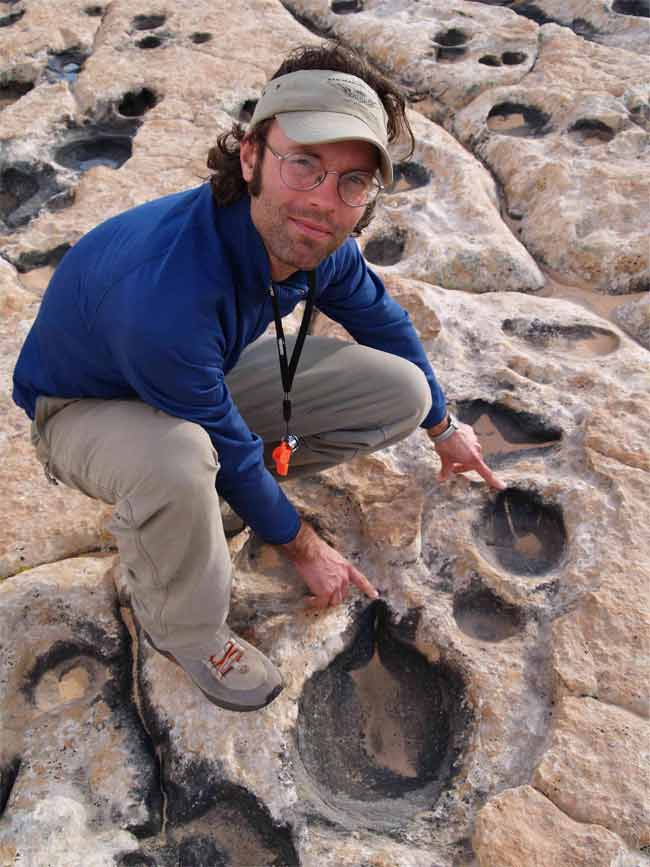Huge Field of Dinosaur Tracks Found

More than 1,000 dinosaur footprints along with tail-drag marks have been discovered along the Arizona-Utah border. The incredibly rare concentration of beastly tracks likely belonged to at least four different species of dinosaurs, ranging from youngsters to adults.
The tracks range in length from 1 to 20 inches (2.5 to 51 centimeters).
"The different size tracks may tell us that we are seeing mothers walking around with babies," said researcher Winston Seiler, a geologist at the University of Utah.
The tracks were laid about 190 million years ago in what is now the Vermilion Cliffs National Monument.
"There must have been more than one kind of dinosaur there," said researcher Marjorie Chan, professor and chair of geology and geophysics at the University of Utah. "It was a place that attracted a crowd, kind of like a dance floor."
While the site is covered in sand dunes now, the researchers say the tracks are within what was a network of wet, low watering holes between the dunes. In fact, the tracks provide more evidence of wet intervals during the Early Jurassic Period, when the U.S. Southwest was covered with a field of sand dunes larger than the Sahara Desert.
Chan and her colleagues, including Seiler, described the dinosaur track site in the October issue of the international paleontology journal Palaios.
Sign up for the Live Science daily newsletter now
Get the world’s most fascinating discoveries delivered straight to your inbox.
By studying the shapes and sizes of the tracks, Seiler suggests four dinosaur species gathered at the watering hole, though the researchers have yet to match the prints with specific species. Currently, the tracks are named for their particular shapes and include:
- Eubrontes footprints measure 10 to 16 inches (25 to 41 cm) long and have three toes and a heel. These tracks likely were made by upright-walking dinosaurs with a body length of 16 to 20 feet (5 to 6 m), or smaller than Tyrannosaurus rex.
- Grallator tracks are about 4 to 7 inches (10 to 18 cm) long, are three-toed and were left by small dinosaurs only a few feet tall.
- Sauropodomorph tracks, more circular than the other types, were left by creatures that walked on four legs and were the largest dinosaurs at the site. Their tracks range from 6 to 11 inches (15 to 28 cm) long. Seiler said the tail-drag marks are associated with these circular footprints, so they likely were made by sauropods.
- Anchisauripus tracks measure 7 to 10 inches (18 to 25 cm) long and were made by dinosaurs that ranged from 6 to 13 feet (2 to 4 m) in length.
Numerous dinosaur track sites have been found in the western United States and elsewhere around the world. For instance, tracks from a herd of 11 giant sauropod dinosaurs were discovered in the ancient coastal mudflats of Yemen. But the new discovery is rare in the density of tracks.
"Unlike other trackways that may have several to dozens of footprint impressions, this particular surface has more than 1,000," Seiler and Chan write.
Chan first visited the site of the dinosaur tracks in 2005 with a U.S. Bureau of Land Management ranger who was puzzled by them. Chan initially called them potholes, which are erosion features common in desert sandstone. "But I knew that wasn't the whole story because of the high concentration and because they weren't anywhere else nearby but along that one surface."
One unnamed reviewer of the Palaios study still believes the holes are erosion features, according to a statement released today by the University of Utah.
In 2006, Seiler saw the tracks and had similar thoughts. "At first glance, they look like weathering pits — a field of odd potholes," he said. "But within about five minutes of wandering around, I realized these were dinosaur footprints."
- Image Gallery: Dinosaur Art
- Avian Ancestors: Dinosaurs That Learned to Fly
- Dino Quiz: Test Your Smarts










